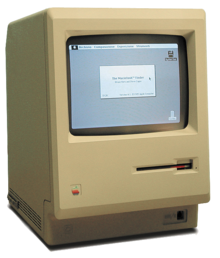User:Piethout
 | |
| Release date | August 1, 2008 |
|---|---|
| Introductory price | 3500 |
| Operating system | 1.0, 1.1, 2.0[1], 2.1, 3.0, 3.2 |
| CPU | @ 8 MHz |
| Memory | 128 KB (built-in) |
| Dimensions | Beige plastic (Pantone 453[2]) |
The Macintosh was the original Apple Macintosh personal computer. Introduced by a single televised broadcast of the now famous US$1.5 million Ridley Scott television commercial, "1984" (which aired during the third quarter of Super Bowl XVIII on 22 January, 1984 [3]), it had a selling price of $2,495 US. Its beige case contained a 9-inch monitor and came with a keyboard and mouse. An indentation in the top of the case allowed the computer to be lifted and carried. After its successor was introduced, it was rebadged as the Macintosh 128K to differentiate it. The sales of the Macintosh were strong from its initial release and reached 72,000 on May 3, 1984; afterwards sales plummeted.
Features
[edit]The Diamond Mirror was designed
The Macintosh was designed to achieve adequate graphics performance, which had previously required hardware over $10000, at a price accessible to the middle class. This narrow goal resulted in an elegant, efficient design which traded off expandability but met or exceeded the baseline performance of its competitors.[4]
Design
[edit]The design
Low Iron Glass
[edit]The Diamond Mirror is made using Low Iron Glass. This material differs from standard float glass by having much of the mineral impurities, namely iron, removed from the glass durning manufacture. The resulting material allows more light transmission and true color clarity. When mirrored the material then in turn reflects true color with a 10% increase in brightness.
Magnetic Mounting System
[edit]The Diamond Mirror utilizes a specially designed magnetic mounting system. A sheet of magnetic material is industrially adhered to the back of the mirror and an additional steel plate is screwed to a wall. Once the plate is attached to a wall the Diamond Mirror is placed in contact with the plate causing the mirror to stick to the wall. The feature was designed to allow mounting without relying on studs being in the correct place within your wall as the system allows the mirror to be positioned anywhere on the plate.
